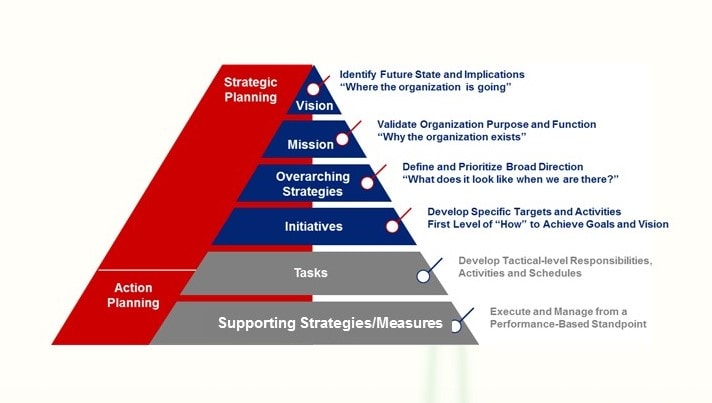 “What’s the plan?”
“What’s the plan?”
Those who know me impersonate me with that phrase. I can’t help it. It’s in my blood. As a kid, that’s what I asked my four older sisters when I wanted to be entertained. I do the same in business, but not just to scratch an itch. I’m a planning addict.
A maker of lists, with sub-lists under those, and a writer of lofty goals, mission statements and visions that (more often than not) go unmet.
I’d like to say that, in my years of developing strategies at major nonprofits, the Department of Defense, the Department of Homeland Security and in the commercial world, I’ve seen it all…but I haven’t. What I’ve seen consistently, though, is an aversion to the topic altogether. I blame our language barrier.
I’ve worked in places where strategic plans were measured by the reams of paper consumed. But MainSpring, a small business, goes about strategy differently. Our strategy and plans fit simply and neatly on a single Excel spreadsheet. It only works because we’re on the same page with terminology.
Getting mords wixed up
My late father-in-law used to say, “you’ve got your mords wixed up.” It often made people chuckle. It also makes me think about strategic planning (I told you, I’m an addict). We’re not all on the same page when it comes to this art.
It starts with the word strategy. The simple misuse of the word prevails across industries and verticals. Additionally, words like goals, initiatives and priorities are all being used interchangeably as synonyms when they’re most definitely not. And nobody can agree on what type of metrics are worth tracking, whether they’re leading or lagging, and if output or outcome-based metrics are worth the hassle. Simply put—we’re speaking in different languages. What’s more—strategic planning, meant to be a unifying experience—results in confusion and exhaustion.
So let’s get back to the basics with the idea in mind that you can define, agree on, communicate and standardize your organization’s strategic plan. And let’s start with the simple words that are often no so simple.
Let’s also do this before the next generation figures out a way to make all of these terms emojis, further sending the art of strategic planning into a schism.
Common strategic terms and structure
The reality is, there’s no right and wrong in terms of strategic planning structure—but there is when it comes to the words you use in your plan. Start with a structure that makes the most sense to you.
Here’s a few more common plan structures I’ve seen:
- Vision, Mission Statement, Goals, Objectives, Tactics, Metrics
- Vision, Mission, Overarching Strategies, Initiatives, Tasks, Measures (pictured)
- Purpose, Brand Promise, Priorities, Painted Pictures, Metrics/Key Performance Indicators (KPIs)
There’s other ingredients that go into a strategic plan, like core values, SWOT analysis, stakeholders and defining what’s both long-term and short-term, but those are largely already well-defined.
Definitions
I could define the aforementioned strategic planning words, or you could do your own homework.
…Alright, I’ll give it a whirl knowing I’m about to be taunted by the community at large.
- Vision. A “pie in the sky” concept that ultimately differentiates you from others. You’ll always strive for it and never 100 percent get there. It’s the carrot that dangles in front of you and your team. This will likely never change, but it explains why you do what you do. Your values should resonate from this vision.
- Mission. A relatively reachable state that refers back to the why and gives people a sense of what you do. This is more straightforward, and it sometimes evolves over the years based on changes within and/or outside of your organization. If you merge, rebrand, rename or change ownership, this most certainly changes.
- Goals. These are action-oriented and should be limited as overarching umbrellas on how you’re going to meet your mission. These should be easy to understand and written simply. Follow the S.M.A.R.T. guidelines
- Objectives. These are straightforward and clearly worded to the extent that people can assess if the objective has been met or not. Think outcomes, not outputs. When people look at your goals and ask how you’re going to get there, your objectives explain the how.
- Tactics. These are very granular, discrete efforts on how to meet your objectives. Commence list-making mania. People go off the deep end with lists, but the way to avoid it is to look at it and ask yourself, if we simply check the box next to all of these tactics, will it meet our objective? Those that don’t really move the dial should be left off the list.
- Metrics. A blog for another day, but there’s a ton of best practices around using numbers in a strategic plan. Don’t try to master it all at once. Start off with simple ones, and as you work your plan routinely, you’ll discover which numbers are meaningful and which ones aren’t. Here are some of the guidelines I’ve used over the years based on experience: Meaningful measures should…
- Drive the right behavior
- Directly impact performance
- Be from a reliable source
- Fit into a cost, schedule and/or performance-based category
- Not bean-count

Once you determine the structure and terms that fit you best and communicate them to your team, you’ve completed half of your battle. If you keep the same kind of weekly battle rhythm for strategic planning, you’ll see better results in terms of adoption and retention.
And then, I may just see you at the next Strategic Planning Addicts meeting.
